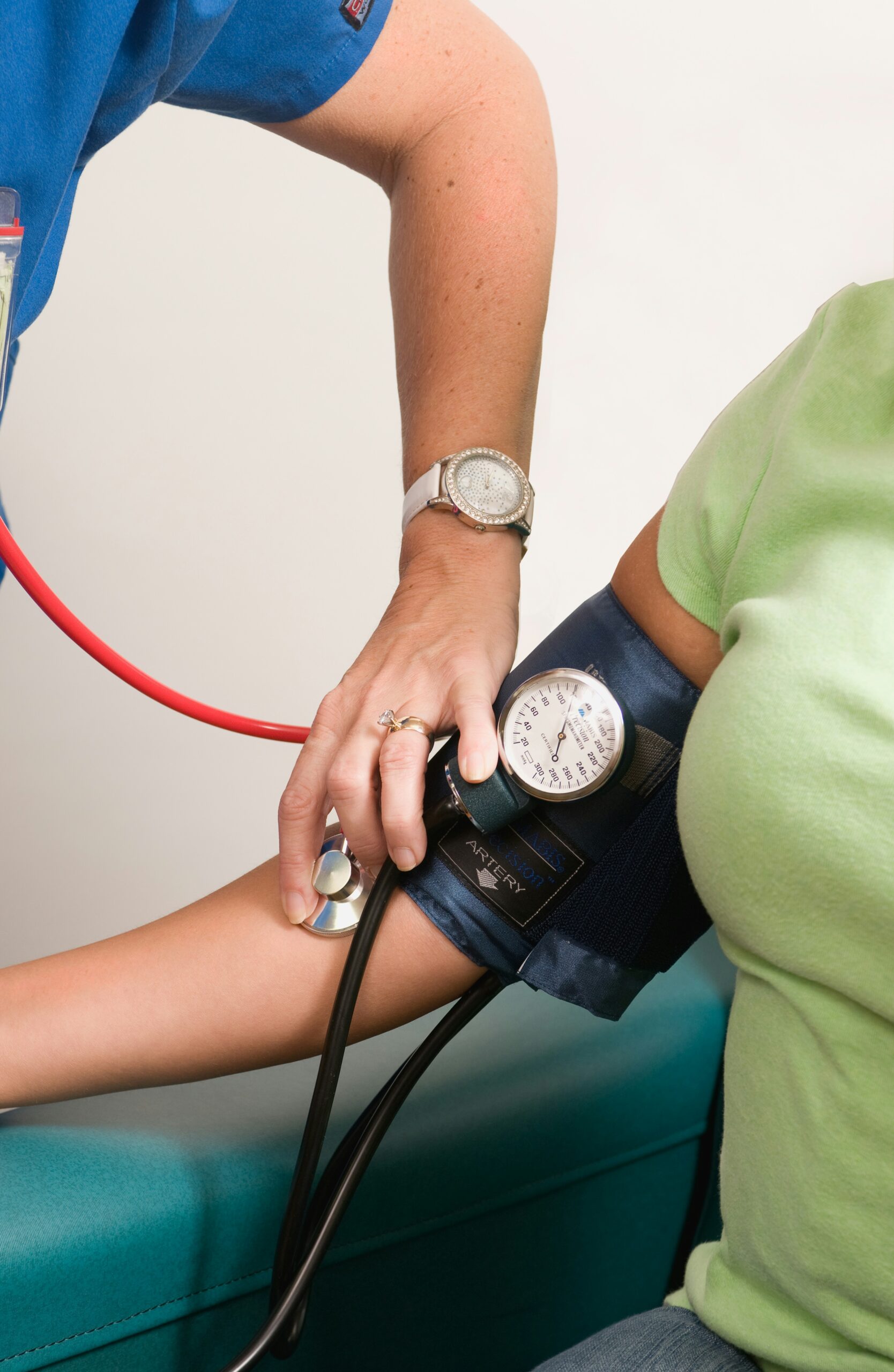Disclaimer: Not everyone who goes through menopause identifies as a woman and not all people who identify as women go through menopause. At Jayla, our core audience is people who identify as women, so we primarily use the word “women.” However, we’re working on specific content for people going through menopause who might not identify women. Inclusivity is a key value of ours, so bear with us!
It’s 3:12 a.m. You’re lying in bed, wide awake, drenched in sweat. Not from a nightmare. Not from a heatwave. Just… your body deciding it’s time for an unscheduled sauna session. Your heart thumps like it’s double-timing a Zumba class, and your mind races with everything from “Did I send that email?” to “Am I dying?” Spoiler: it’s probably perimenopause—and your blood pressure’s not loving the drama either.
The research points to a mix of factors including genetics, inflammation, hormone sensitivity, and systemic stress. And yes—racism and bias in healthcare (unsurprisingly) play a role, influencing everything from diagnosis to treatment options. (5, 6) This is consistent with the concept of weathering: the idea that chronic exposure to stress, particularly racism, can wear down the body over time and contribute to higher rates of conditions like fibroids. (7)
The Symptom That No One Talks About
You’ve probably heard about hot flashes, mood swings, and night sweats as classic signs of perimenopause. But high blood pressure? That one rarely gets mentioned — and yet, it matters just as much.
As estrogen levels begin to fluctuate and decline, your risk of developing high blood pressure starts to climb. It doesn’t always come with obvious warning signs, and many women don’t realize anything’s changed until it shows up during a routine check-up — or after a health scare.
The connection between perimenopause and high blood pressure is real, and often overlooked. Here’s why it’s time to start paying attention — and what you can do to protect your heart during this stage of life.
Why Does Perimenopause Cause High Blood Pressure?
Nearly 1 in 3 women over 40 has high blood pressure — but many don’t know it. (1)
Your body is going through a lot in perimenopause — and not just with your cycle. Hormonal shifts during this time can have a big impact on your cardiovascular system, including your blood pressure. Here’s how it works:
The Estrogen Connection
Estrogen does more than regulate your menstrual cycle — it also helps keep your blood vessels relaxed and flexible, making it easier for blood to flow. But as estrogen levels start to decline in perimenopause, arteries can become stiffer and narrower. That means your heart has to work harder to pump blood through your body, which can cause your blood pressure to rise. (2)
Sleep, Stress, and Hormones
Perimenopause often brings more stress and worse sleep, both of which affect your blood pressure. But, don’t panic, it’s not all doom and gloom—there are ways to manage these symptoms. (3)
Fluctuating hormones (especially cortisol, your body’s main stress hormone) can keep your nervous system on high alert. Combine that with poor sleep from night sweats or anxiety, and you’ve got a recipe for elevated blood pressure. It’s not “just stress” — our body’s chemistry is actively shifting in response. (4)
Body Changes and Metabolism
Many women notice weight creeping up during perimenopause—especially around the belly. And it’s not just something that can rattle our confidence, it can also affect our blood pressure. This shift in body composition happens partly because of changing hormones and partly because metabolism slows down with age (5). That extra belly fat isn’t just padding—it’s often visceral fat, which wraps around internal organs and is more metabolically active. It’s linked to increased inflammation and insulin resistance, both of which can raise your risk of high blood pressure (6). So it’s not just about the number on the scale; it’s about what’s going on inside your body as well.
If your heartbeat just jumped a little reading that — we promise, you’re not the only one. These changes can be tough because they don’t just affect your body or mind separately—they’re connected. Physical symptoms like blood pressure spikes can disrupt sleep and mood, while stress and emotions can make those symptoms worse. Knowing how they interact helps you manage them with more confidence and care – and that’s what we’re here for.
Why High Blood Pressure Is Often Missed In Perimenopause
Let’s take a step back to explore why high blood pressure is one of the most common—but least talked about—symptoms of perimenopause.
High blood pressure during perimenopause is often overlooked because its symptoms—like fatigue and brain fog—are subtle or easily attributed to stress, aging, or hormonal changes. (7) In the rare (but thankfully increasing) cases where perimenopause is acknowledged in clinical settings, the focus is often on managing hormonal symptoms, leaving cardiovascular health under-assessed. (8) Gender and racial biases in healthcare also contribute to disparities in diagnosis and treatment of hypertension during this time. (9)
For Black women, the concept of weathering—the cumulative impact of chronic stress and systemic racism—makes early and severe blood pressure problems more common. (10)
Managing High Blood Pressure During Perimenopause
Perimenopause isn’t a life sentence — it’s a natural phase of life. However, the symptoms can last up to a decade, so it’s worth managing them. There are ways to feel better, and we strongly recommend you explore them. Don’t just “deal with it” — support your body and mind through the changes.
Track your blood pressure
Start by getting your blood pressure checked regularly — at your doctor’s office and, if possible, with a home monitor. Knowing your numbers is the first step toward control and can be incredibly empowering. (11) If you’re using a smartwatch to measure your blood pressure, that’s a smart first step toward monitoring your health. Just keep in mind that these readings can sometimes differ quite a bit from those taken with a clinical-grade cuff.
Lifestyle swaps
You may have read “lifestyle swaps” and thought “oh no…”. Don’t worry, we’re not asking you to completely change your lifestyle. Small changes add up:
- Reduce salt, boost potassium
Swap salty snacks for potassium-rich foods like leafy greens, beans, and bananas — your arteries will thank you. (12)
- Move your body.
You don’t need to run a marathon; even a daily walk or dance break helps keep your heart healthy. (13)
- Prioritize sleep.
Quality shut-eye can lower stress hormones and blood pressure. Try calming bedtime rituals or adjust your sleep environment. (14)
- Manage stress.
Journaling, therapy, breathwork — whatever helps you reset, go with it. Your nervous system needs that pause. And if you’re thinking, “Ugh, I don’t have time to relax,” you might be exactly the person who needs it most (yep – we see you).
Talk to a doctor
Be your own advocate. Ask about how perimenopause affects your heart health and what screenings or treatments might be right for you. Don’t hesitate to bring up symptoms you think might be “just perimenopause.” Your health matters (7).
Find clinicians that really understand perimenopause. At Jayla Health, our clinicians are trained in perimenopause care. With Jayla’s FSH at-home hormone test, you’ll get a clearer picture of your hormone activity — one of the key drivers behind perimenopause-related changes, including blood pressure spikes. Once your results are in, you’ll review them with a perimenopause specialist and co-create a personalized care plan. That might include strategies like hormone therapy, nutrition guidance, lifestyle changes, or holistic approaches—all aimed at helping you manage both your symptoms and your blood pressure with more confidence.
Cultural Foods and Heart Health
Food is an essential part of heart health and blood pressure, but fear not – we’re not asking you to switch to a mediterranean diet. Forget the myth that eating healthy means bland, boring, or only “Western” food. Each culture’s traditional dishes can be heart-healthy and delicious:
– Turmeric in South Asian cuisine is a natural anti-inflammatory superstar. (16)
– Greens and legumes in African American soul food bring fiber and nutrients that support blood pressure. (17)
– Olive oil, garlic, and tomatoes in Mediterranean diets have long been linked to heart health. (18)
– Fermented foods in East Asian cuisine, like kimchi and miso, promote gut health, which influences inflammation and heart health. (19)
– Yams and plantains in African and Caribbean cuisine provide fiber, potassium, and complex carbohydrates that support heart health and help regulate blood pressure. (20)
Healthy eating doesn’t mean giving up your roots — it means embracing them in ways that nourish your heart.
You’ve got this
Perimenopause affects more than just your cycle — it impacts your heart, too.
Staying informed and empowered helps you take charge of every symptom that comes your way.
When it comes to high blood pressure: know your numbers, trust your body, and remember — you’ve got this.
References
1. American Heart Association, 2023. High Blood Pressure in Women. [online] Available at: https://www.heart.org
2. Vongpatanasin, W. (2021). Hypertension in women: Current understanding and future directions. Hypertension, 78(1), 15–23.
3. Baker, F.C., & Driver, H.S. (2007). Circadian rhythms, sleep, and the menstrual cycle. Sleep Medicine, 8(6), 613–622.
4. McEwen, B.S. (2007). Physiology and neurobiology of stress and adaptation: central role of the brain. Physiological Reviews, 87(3), 873–904.
5. Lovejoy, J.C. (2003). The menopause and obesity. Primary Care Companion to The Journal of Clinical Psychiatry, 5(6), 262–265.
6. Grundy, S.M. (2004). Obesity, metabolic syndrome, and cardiovascular disease. Journal of Clinical Endocrinology & Metabolism, 89(6), 2595–2600.
7. Vongpatanasin W. (2021). Hypertension in women: Current understanding and future directions. Hypertension.
8. Muka T, et al. (2016). The role of menopause in cardiovascular disease risk: An update. Climacteric.
9. Virani SS, et al. (2020). Heart disease and stroke statistics—2020 update: A report from the American Heart Association. Circulation.
10. Geronimus AT, et al. (1992). Weathering and age patterns of allostatic load scores among blacks and whites in the United States. American Journal of Public Health.
11. Pickering, T.G., et al., 2008. Recommendations for blood pressure measurement in humans and experimental animals: Part 1: blood pressure measurement in humans: a statement for professionals from the Subcommittee of Professional and Public Education of the American Heart Association Council on High Blood Pressure Research. Hypertension, 45(1), pp.142-161.
12. Whelton, P.K., et al., 2018. 2017 ACC/AHA/AAPA/ABC/ACPM/AGS/APhA/ASH/ASPC/NMA/PCNA guideline for the prevention, detection, evaluation, and management of high blood pressure in adults. Hypertension, 71(6), pp.e13-e115.
13. Pescatello, L.S., et al., 2015. Exercise and hypertension. Medicine and Science in Sports and Exercise, 47(6), pp.1229-1237.
14. Buxton, O.M. & Marcelli, E., 2010. Short and long sleep are positively associated with obesity, diabetes, hypertension, and cardiovascular disease among adults in the United States. Social Science & Medicine, 71(5), pp.1027-1036.
15. Hughes, J.W., Fresco, D.M., Myerscough, R. & Van Dulmen, M., 2013. Cognitive-behavioral stress management reduces stress, anxiety, and blood pressure in women with prehypertension. Annals of Behavioral Medicine, 45(2), pp.172-183.
16. Aggarwal, B.B. & Harikumar, K.B., 2009. Potential therapeutic effects of curcumin, the anti-inflammatory agent, against neurodegenerative, cardiovascular, pulmonary, metabolic, autoimmune and neoplastic diseases. The International Journal of Biochemistry & Cell Biology, 41(1), pp.40-59.
17. Satia-Abouta, J., Patterson, R.E., Neuhouser, M.L. & Elder, J., 2003. Dietary acculturation: applications to nutrition research and dietetics. Journal of the American Dietetic Association, 103(8), pp.980-986.
18. Estruch, R., et al., 2018. Primary prevention of cardiovascular disease with a Mediterranean diet supplemented with extra-virgin olive oil or nuts. The New England Journal of Medicine, 378(25), pp. e34.
19. Marco, M.L., Heeney, D., Binda, S., et al., 2017. Health benefits of fermented foods: microbiota and beyond. Current Opinion in Biotechnology, 44, pp.94-102.
20. U.S. Department of Agriculture. (2024). FoodData Central: Yams, raw. [online] Available at: https://fdc.nal.usda.gov/fdc-app.html#/food-details/169910/nutrients [Accessed 24 Jun. 2025].



